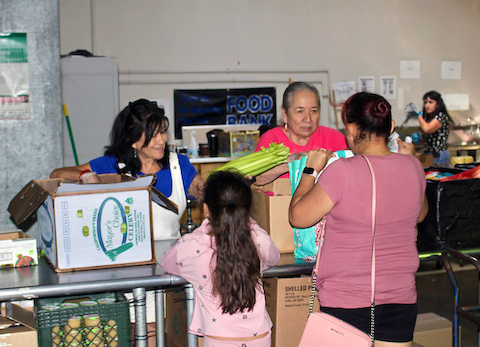
11 Nov SNAP Delays Sign of Greater Threat to Social Safety Net, Advocates Say

Volunteers at the Ukiah Food Bank distribute food on Wednesday, Aug. 27. (Sydney Fishman / Bay City News)
By Samantha Kennedy
Part of the 5.5 million people in California who receive food assistance through CalFresh haven’t received their benefits because of the federal government shutdown, but advocates say the roadblock is only one part of the plan to dismantle safety net programs.
Over a month into the shutdown, the federal Supplemental Nutrition Assistance Program, or SNAP assistance nationwide was set to go unfunded for November due to a lack of funding. Two federal judges on Oct. 31 ruled that funding must be made available, even at a reduced amount, but benefits were still delayed.
At least some SNAP recipients have started receiving their November benefits late. Richmond’s city manager sent out a notice on Nov. 9 advising people to see if they have gotten theirs by visiting BenefitsCal.com or simply trying to use their EBT card. Those who still haven’t gotten their benefits should call (866) 663-3225 or visit a county Employment & Human Services Department office in Richmond, Hercules, Pleasant Hill or Antioch. People in need can get free food boxes at those locations and may be eligible for an emergency debit card to replace missing benefits.
“If you look at Project 2025, they’re pretty much following that guideline in how to create chaos, panic, and seeing how they are looking at other ways — proposed rule-making, administrative avenues — to even further cut the program, ” said Gina Plata-Nino, the interim director of SNAP at the Food Research and Action Research Center, at an Oct. 31 American Community Media briefing.
Since January, the Trump administration has already implemented expanded work requirements for certain SNAP recipients that went into effect this month, and cut the program by $186 billion over the next 10 years as part of the “One Big Beautiful Bill.” The changes put hundreds of thousands of Californians at risk of losing some of their benefits, advocates estimate.
Over 100,000 CalFresh recipients in Contra Costa were in danger of not receiving any benefits at all, thanks to the shutdown, but, like other leaders at the local and state level, county officials have stepped in to help bridge the gap.
Supervisors earmarked up to $21 million to issue debit cards to CalFresh recipients. Each card will have a similar amount to each family’s usual benefits for the month.
Contra Costa County, officials in Santa Clara County and Gov. Gavin Newsom have used tens of millions of dollars to help food banks feed families, but that’s not the solution, said Jamie Bussel, a senior program officer at the Robert Wood Johnson Foundation.
“They do not replace the SNAP program. To give you a sense, for every meal a food bank is able to provide, the SNAP program provides nine,” said Bussel.“And the ripple effects are enormous.”
Losing eligibility for SNAP can also disqualify children from other safety net programs that require eligibility, such as summer feeding programs and school breakfast and lunch.
In California, students do not have to qualify for the program to get free school meals, but SNAP recipients can qualify for programs like PG&E’s monthly bill discount after showing they receive the food assistance.
Joseph Llobrera, director of research for the food assistance team at the Center on Budget and Policy Priorities, said the USDA’s initial decision not to use contingency funds to fund SNAP was “deeply concerning.”
“The [Trump] administration absolutely has the legal authority and responsibility to release SNAP benefits in November,” Llobrera told reporters.
On its website, the USDA said the “Senate Democrats have now voted 13 times not to fund the food stamp program,” adding that the “well had run dry.”
But the department caved Nov. 3, writing in court filings that it would use about $4.6 billion to make partial payments to recipients nationwide. Those payments, which typically total $8 billion per month for the country, are likely to take “several weeks” to be paid, according to USDA Secretary Brooke Rollins.
“The Trump administration is choosing to take food off the table. Families should not go hungry because of that choice,” said Llobrera. “I’m hoping with [the two federal rulings] that the USDA will move quickly to minimize the disruptions that families will experience.”






No Comments